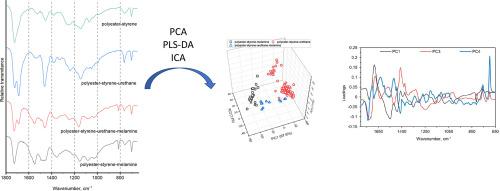Rapid forensic characterization of automotive clear coats by ATR-FTIR combined with chemometrics
IF 3.7
Q1 CHEMISTRY, ANALYTICAL
引用次数: 0
Abstract
Hit-and-run criminal behavior is a challenge for law enforcement agencies around the world. Paint chips left at a crime scene become important for the criminal investigation process. The clear coat is of great interest since it is most likely to be transferred through contact and therefore found at the crime scene. Fourier transform infrared spectroscopy with attenuated total reflectance (ATR-FTIR) spectroscopy combined with chemometric tools is shown to efficient for forensic examination of clear coats. The possibility of improving the chemometric model generalizability was shown through a dataset encompassing diverse 125 samples. The chemical signatures of melamine cross‐linking and urethane were observed during investigation of spectral data of individual clear coats. The best exploratory principal components analysis (PCA) model was constructed with the first four principal components (PCs), that described 90.3 % of the total data variance. Supervised model classification using partial least squares – discriminant analysis (PLS-DA) showed ssensitivity (SEN) and specificity (SPC) of 95 % and 100 % for external test set (overall accuracy was 92 %). Independent components analysis (ICA) model with 6 independent components (ICs) was used to interpret chemical features responsible for class separation. High predictive ability and interpretability of multivariate approach demonstrates the potential of ATR-FTIR spectroscopy and chemometrics for characterization of automotive clear coats of various manufacturers and models.

ATR-FTIR结合化学计量学对汽车透明涂层的快速法医鉴定
肇事逃逸的犯罪行为对世界各地的执法机构来说都是一个挑战。犯罪现场留下的油漆碎片对刑事调查过程非常重要。这件透明外套引起了极大的兴趣,因为它很可能是通过接触转移的,因此在犯罪现场被发现。傅里叶变换红外光谱与衰减全反射(ATR-FTIR)光谱结合化学计量工具被证明是有效的法医检查透明涂层。通过包含125个不同样本的数据集显示了提高化学计量模型泛化性的可能性。通过对单个透明涂层光谱数据的研究,观察到三聚氰胺交联和聚氨酯的化学特征。最佳的探索性主成分分析(PCA)模型是由前四个主成分(PCs)构建的,它们描述了总数据方差的90.3%。使用偏最小二乘判别分析(PLS-DA)的监督模型分类显示,外部测试集的敏感性(SEN)和特异性(SPC)分别为95%和100%(总体准确率为92%)。采用具有6个独立成分的独立成分分析(ICA)模型来解释导致类分离的化学特征。多元方法的高预测能力和可解释性证明了ATR-FTIR光谱和化学计量学在不同制造商和车型的汽车透明涂层表征方面的潜力。
本文章由计算机程序翻译,如有差异,请以英文原文为准。
求助全文
约1分钟内获得全文
求助全文

 求助内容:
求助内容: 应助结果提醒方式:
应助结果提醒方式:


